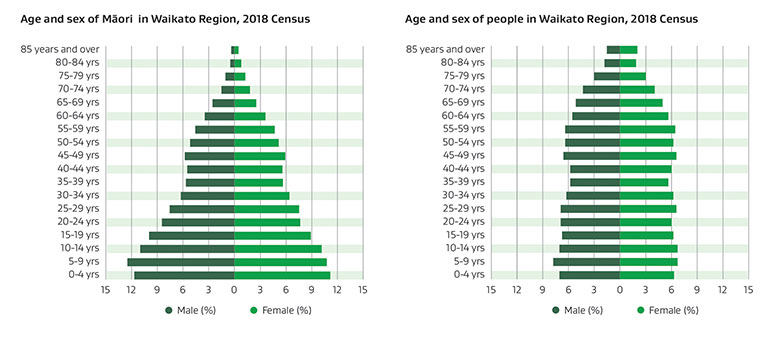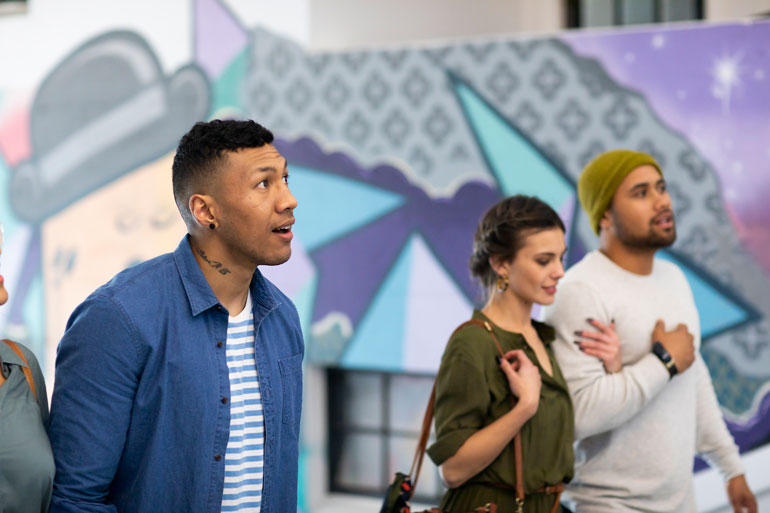Te Ao Māori
On this page
Ko Mōkau ki runga, Mōkau is above
Ko Tāmaki ki raro, Tāmaki is below
Ko Mangatoatoa ki waenganui. Mangatoatoa is between.
Pare Hauraki, Pare Waikato, The boundaries of Hauraki, the boundaries of Waikato.
Te Kaokaoroa-o-Pātetere. To the place called the long armpit of Pātetere.
The Waikato RSLG region lies within the Tainui Waka boundary, as described in this pepeha. From a Te Ao Māori world view, the North Island is widely known as Te Ika a Maui (the fish of Maui), with its head, Te Upoko o te Ika, being in the Wellington area. Te Ao Māori view the head as the most sacred part of the body, therefore in reference to its geographic location to the head of the fish, Mōkau is described as located above. These geographic markers not only denote the richness of whakapapa linking iwi within the region, but they also highlight the ecosystem of relationships that are crucial in progressing peoples’ aspirations for sustainable growth from a Te Ao Māori view.
The Te Ao Māori view of success is a collective success in cultural retention and dissemination, and the achievement of social outcomes for people. “When economic, cultural and social outcomes of success are attained as joint outcomes then we are more likely to be achieving Māori wellbeing.” - Distinguished Professor Graham Hingangaroa Smith.
He Mangōpare Amohia: Strategies for economic development [PDF 3.2MB](external link)
Iwi and Māori entities from within the region, continue to support sustainable economic development strategies that will benefit future generations. The Māori economy is now a $70 billion sector with significant growth potential emerging post-settlement.
What’s driving the Māori economy(external link) — Newsroom
The plan for future growth is detailed in Te Whare Ohaoha, the Waikato Region Māori Economic Development Action Plan Refresh of 2019. Te Whare Ohaoha provides the necessary framework and the endorsement from key stakeholders to “…provide an opportunity for Māori in the Waikato Region to work with and among fellow stakeholders to lift the overall economic performance of the region’s financial and physical, human, social, cultural and natural capitals, with the intention of raising the living standards and intergenerational wellbeing of Waikato Māori.”
Te Whare Ohaoha – Waikato region Māori economic development action plan refresh: A 12 month refresh [PDF 4.0 MB](external link) — Waikato Regional Council
Te Whare Ohaoha is supported by 3 pou (pillars):
- Te Poukaiāwha: Māori Collectives
- Te Poutokomanawa: Whānau Enterprise
- Te Poutūārongo: Rangatahi
The Poutūārongo pillar resonates with the RSLG focus on rangatahi space, alongside Waikato Plan and Waikato Wellbeing Project partners. This pillar asserts that the development of capable, confident rangatahi is essential for economic prosperity in the region. In 2018, it was estimated that 57% of Māori living in the region were under the age of 30 years.
Population Structure(external link) — Waikato Regional Council
Through its regional engagement, the RSLG has identified active initiatives that support the development and wellbeing of rangatahi as leaders. Rather than adding further initiatives, the RSLG will partner with iwi/Māori to advance their workforce development aspirations, including completing a stocktake of the various initiatives across the region to analyse their effectiveness and identify opportunities to increase the most impactful activities.

Text description
Te Ao Māori actions
-
Identify opportunities to partner with iwi/Māori entities to support the delivery of existing workforce development actions that relate to the future of work.
-
Support capability building programmes for Māori owned businesses across the Waikato to enable them to fully benefit from social procurement provisions.
Case study: Building capability in our Māori enterprises
Te Waka, supported by Te Puni Kōkiri and Ministry of Social Development, and in partnership with Waikato Tainui, is currently leading a project to support the development of pathways designed to increase small and medium-sized (SME) Māori business ability to participate in supplier diversity procurement opportunities across the Waikato. The project, running until December 2022 aims to:
- Identify and create pathways for Māori SMEs to address capability and capacity gaps, including identifying appropriate services providers to support upskilling
- Identify funding pathways
- Create an Iwi focused pilot, in collaboration with Waikato Tainui
- Create a second model that supports Iwi that are in a pre-treaty settlement space.
The outcomes of this project will inform future iterations of this Regional Workforce Plan.


